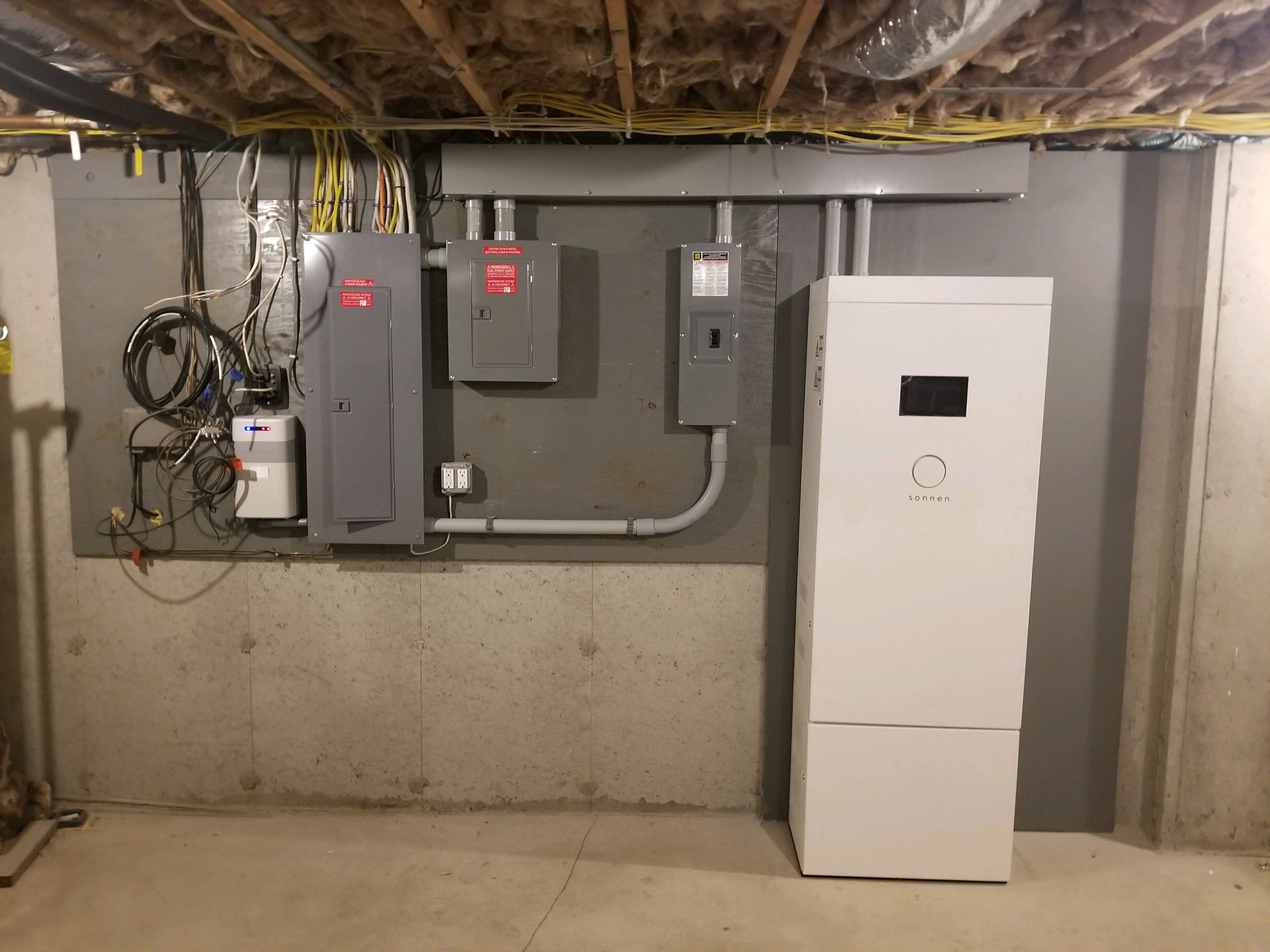Southampton Looks To Power A Green Future

Batteries can be a big benefit now, and in the future, and Southampton Town could help steer residents in the right direction while inching closer toward its goal of utilizing 100-percent renewable energy.
Lithium-ion smart batteries are being used in homes like backup generators, connecting to the grid or to a solar panel system, and can potentially be an alternative to net metering when that program is withdrawn at the end of the year. Net metering is a PSEG program designed to incentivize residential adoption of solar by allowing consumers who generate some or all their own electricity to use that electricity anytime, instead of just when it is generated. Every kilowatt-hour injected into the grid is credited to the PSEG bill.
While existing net-metered ratepayers will be grandfathered for 20 years, Long Island solar developers fear that without financial incentives, the solar business will go over a cliff on January 1, said Sustainable Southampton Green Advisory Committee member Lynn Arthur, who chairs the energy sub-committee.
Home storage batteries can offer net metering-like capability, if or when it’s not available, and provide a grid service called peak shaving, which is the process of reducing the amount of energy purchased from the utility company during peak demand hours. While the only current Long Island use for batteries is as backup energy, and reducing one’s carbon footprint, Arthur sees a future municipal-led battery program that shares the economic benefit with residents.
“Curtailment has a quantified financial value,” Arthur said. “If you had to choose between subsidizing a home battery storage system versus paying a third party to run a carbon-based emergency generator as a peaker plant during those few hours when electric load is spiking, which would you choose?”
Uses For Batteries
According to Andy Smith, sales manager with Southampton-based GreenLogic LLC, batteries could be connected to solar panels to create what’s called “islanding.” For instance, it would make sense to put solar on the cabin that has electrical lines and poles running down to the main road, and use a battery to store the energy taken in from the panels to be used later.
“What would happen is the solar would run everything during the day and the battery would run everything at night,” Smith said. “You’d be an island of your own.”
If a solar system isn’t installed by December 31, utility companies will be buying back excess energy households create that isn’t immediately consumed. However, instead of getting a one-for-one exchange, the surplus energy will be sold to the grid for 65 cents on the dollar, Smith said.
In addition to peak shaving, batteries can reduce the amount of energy purchased from the utility company during high-demand hours, which tend to be between 4 to 8 PM. If there’s a time-of-use surcharge, or a rate reform, which Smith believes is coming, a consumer will pay more for his or her energy during those hours, like when everyone’s getting home from work and cranking their air conditioners. Stored energy in a battery that has been taken in from solar or from the grid at a lower price point will be dispersed during this time.
“Basically, that’s arbitrage,” Smith said. “You’re using cheaper energy during the day and buying it at night. You’re therefore saving that differential, which creates a return on investment.”
The first two uses each create an return on investment, because instead of selling excess energy to the grid at 65 cents on the dollar, a homeowner storing the energy inside a battery means for every kilowatt hour not net-metered out, they save 35 cents on the dollar.
“Those are the two ways the battery could actually pay for itself at some point,” Smith said. “You can calculate it.”
Solar does not work when the grid is out, because there’s a safety valve in the inverter that shuts it down to protect linemen from being electrocuted when working on the grid. “The only way to have solar work if there’s a power outage is by using a smart battery,” said Smith.
Batteries can also charge from the grid and sit in standby mode until needed to help power the essential loads, which include refrigerators, freezers, heat sources, and modems, operational struggles homeowners without power faced during Superstorm Sandy.
First-hand Accounts
Montauk resident Jay Levine installed solar panels and a battery in his home last October. While he has not had to use it since, he integrated this system to protect his essential loads, which for him and many other East End residents also includes access to water, because he relies on a well pump.
“Historically, if you go back 10 to 15 or more years, our electric service was somewhat tenuous during major storms,” Levine said. “Also, living in Montauk, we’re susceptible to being cut off from the rest of Long Island. We can be overwhelmed by ocean storms. We felt that rather than installing a diesel or gas generator that a battery backup was a more reasonable, environmentally-responsible approach.”
A Sonnen battery was installed in his basement in a unit the size of a refrigerator, with the battery in the bottom half and wiring and electrical switches in a cabinet above. It is controlled via an app that allows him to see a usage dashboard and his battery life.
The technology is so smart, that if a homeowner knows he or she is going to be out of power for a particular amount of time, and say, it’s during a snow or ice storm where it will take at least hours if not days for the buildup on the solar panels to melt, he or she can budget usage to ensure battery life until the grid is up and running. The lithium ion phosphate battery can also be backed up with a portable generator, charged in an hour or two.
“The whole idea of being independent of the grid if we needed to, was very attractive to me,” Levine said. “If the grid fails, we could go on indefinitely as long as the sun comes out.”
Levine said he’d urge others to explore solar and battery connection.
“The solar panels and the battery backup are consistent with my wife and my views of our need to reduce our carbon footprint, reduce our dependence upon fossil fuels,” Levine said. “The more solar panels we have on roofs, the less dependent on imported oil and coal and gas-fired generators we’ll be. We have to do it. If you take the long view, we’re going to break even on our panels in about 10 years. I think of it like we paid an advance on our electricity, and in year 11, we have free electric. No energy costs. Why wouldn’t you do that? On the South Fork, there’s a lot of people with the means to do this.”
How The Town Can Get Involved
Arthur said the sustainability committee’s interest in batteries started when Governor Andrew Cuomo doubled down on his renewable energy targets. At the same time, the South Fork Peak Savers program managed by Applied Energy Group, a PSEG subcontractor, created a new offering that seemed in conflict with the state and local renewable goals.
Since 2016, AEG has successfully delivered load reduction via elements of its program, including energy efficiency measures, smart thermostats, and energy-efficient lighting. But in January, South Fork businesses with existing gas- or diesel-fueled emergency generators were being solicited by South Fork Peak Savers to run their generators on demand for payment during hot summer days, like during the recent heat wave, when load on the South Fork was spiking. Instead of contributing greenhouse gases with these carbon-based generators, Arthur is pursuing a program modeled along the lines of South Australia’s Virtual Power Plant initiative with Tesla, or Vermont’s Green Mountain Power, where residential customers are offered a chance to own a Tesla Powerwall battery for a reduced price on a 10-year payment plan.
In exchange for the reduced price, homeowners cede some control over the battery so that Green Mountain Power could remotely charge and discharge participating batteries to the grid according to forecasts on peak demand.
Green Mountain Power invested $8 million of its own money up front based on an investment decision that it would recoup that money over time. The company says its Virtual Power Plant saved $500,000 in just one week in the summer of 2018 as temperatures soared during a heat wave. First, by tapping into its Virtual Power Plant system, it was able to avoid buying electricity from other power generators at peak prices. The cost of electricity from the grid is adjusted every five minutes — as demand goes up, so do the prices.
But there is a second factor in play, that by drawing on its own resources, Green Mountain Power was able to reduce its payments to the bulk transmission system for the New England region. That charge is based on usage during the hour of the year when the most electricity was being used. By relying on all those Powerwall batteries, Green Mountain Power skipped that peak hour.
Arthur said she’s looking to discuss the topic of batteries and a municipal-led program in detail with the town board in September, and said she’s confident this model will appeal to residents because “local control, transparency, and choice build trust.”
In the meantime, Councilman John Bouvier, who also sees the benefits to batteries, has some of his own ideas. First and foremost, he would like to create legislation to allow for emerging technology. Knowing that there are about three million car batteries used in electric vehicles that are eligible to be recycled for use in residential homes also interests him.
“We need to have laws that allow for that in a safe way, that meets other state and county codes,” he said.
The councilman and Arthur believe the town can act as a model, as it has with the American Green Zone Alliance, whereby the town is converting to electric lawn maintenance equipment, and educating the public.
Bouvier also noted Riverhead Town recently decided to become a climate-smart community. Considering the two parties are interested in perusing Community Choice Aggregation possibilities, readying to issue a request for proposal based on a law passed a month ago, Bouvier and Arthur are also hoping to incorporate smart batteries into the proposal.
“We have some really strict residential new building code here that has resulted in energy-efficient houses, so we want to encourage people to use alternative energy sources,” Bouvier said.
desiree@indyeastend.com



